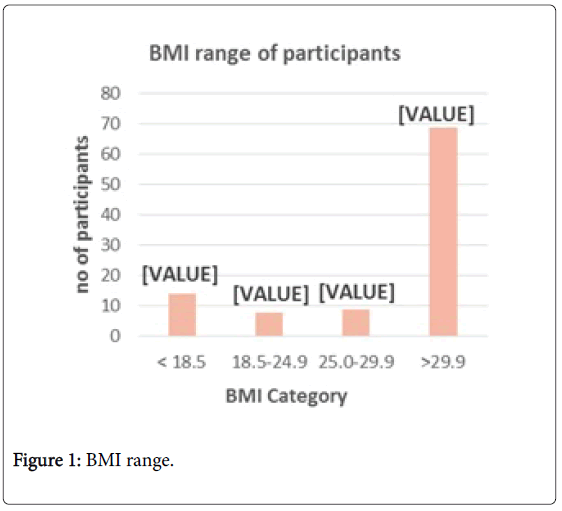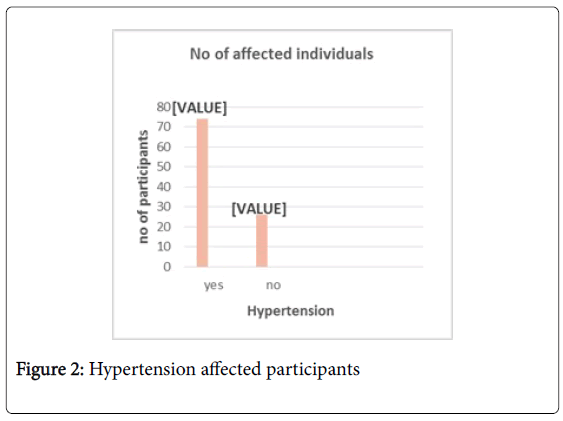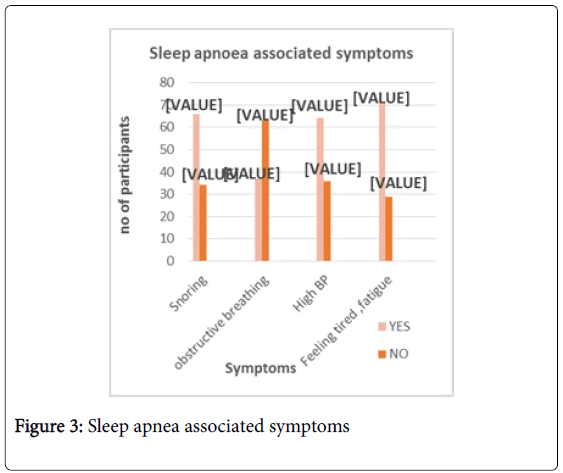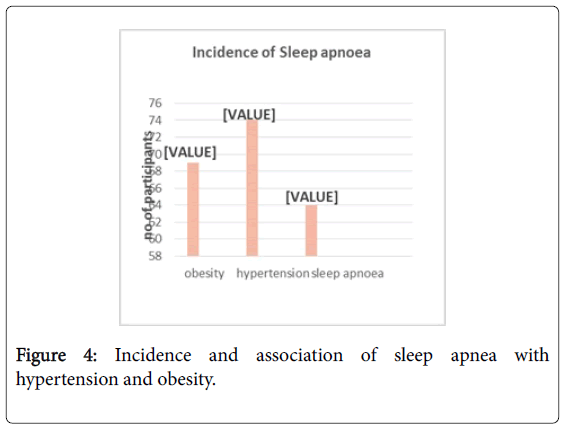Obesity and Hypertension Induced Sleep Apnea in Men
Received: 31-Jul-2017 / Accepted Date: 24-Aug-2017 / Published Date: 01-Sep-2017 DOI: 10.4172/2165-7904.1000351
Abstract
Global obesity and hypertension epidemic continues to gain momentum as reported in several studies that association between obstructive sleep apnea, hypertension and weight gain has resulted in a corresponding increase in the frequency of this health issue. Therefore this analytical study was conducted with the help of a selfdeveloped validated questionnaire designed to find the prevalence of sleep apnea and its relationship with obesity and hypertension in 100 male participants. Obtained results revealed that out of 69 obese male individuals, 64 were suffering from sleep apnea along with apparent symptoms of hypertension indicating its high prevalence. If untreated, may affect quality of life, morbidity and mortality.
Introduction
Sleep apnea causes daytime hypertension since previous studies showed that patients with sleep apnea had high incidence of clinical hypertension [1,2]. However, in specific, hypertension may be caused by a number of other factors that includes obesity, age, high alcohol intake, smoking, low exercise and high caffeine intake [3-13]. Early findings indicated that sleep apnea is associated with hypertension and obesity [14-17]. Epidemiologic studies indicate a direct association between hypertension and obesity [18]. According to an investigation it was found that 78% of hypertension in men and 65% in women can be linked to rapid weight gain [19]. But in some studies a direct relation was discovered between BMI and blood pressure [20].
Nevertheless, correlation between excessive weight gain and hypertension is multifarious caused by interaction of different genetic, hormonal, environmental and demographic factors. Therefore underlying link between sleep disordered breathing, hypertension and obesity is far from proved, though there are good theoretical reasons for suspecting that such a link might exist. Obesity and sleep apnea often coexist and is dependent on one another. Hence it is quite convincing that affiliation of obesity and hypertension is related to the existence of obstructive sleep apnea. Examining of sleep apnea is not that easy due to night to night variation and also because it is still vague that what factors might trigger hypertension in an individual [21]. Thus it is difficult to design experiments with hundred percent reliability and accuracy to investigate the causal links between sleep apnea, hypertension and obesity; it is indeed besieged with difficulties. So in order to get to the root of this disorder one must first find out the contributing factors which provoke sleep apnea and then explore its correlation with obesity and hypertension. These must then be accounted to propose that sleep apnea is a health hazard worthy of attention. Therefore the main aim of this study was to determine that sleep apnea might be strongly linked with obesity and hypertension in men.
Materials and Methods
Male participants were selected at random with their informed consent keeping the sample size 100. Male participants with age ranges from 35-45 years were included in the study. This analytical study was conducted with the help of a self-developed validated questionnaire designed to find the prevalence of sleep apnea and its relationship with obesity and hypertension. BMIs of the individuals were also calculated using the given formula to assess the weight status of the participants. Participants were also categorized as normal, under/overweight and obese based on their measured BMIs. Based on the measured blood pressure using sphygmomanometer, individuals were recognized with the condition of hypertension. Statistical analysis of the data was done by means of Microsoft excel.
Results & Discussions
Out of 100 male participants, 69% were found to be obese while 9 % were overweight as depicted in Table 1 and Figure 1.
| S.no | BMI category | Weight range | No of students (%) |
|---|---|---|---|
| (n=100) | |||
| 1 | <18.5 | Under weight | 14 |
| 2 | 18.5-24.9 | Normal | 8 |
| 3 | 25.0-29.9 | Over weight | 9 |
| 4 | >29.9 | Obese | 69 |
Table 1: BMIs of male participants.
Numerous studies have reported that a consistent relationship occurred between obesity and sleep apnea [22]. As indicated by the obtained result that out of 69 obese male individuals, 64 were suffering from sleep apnea. Similarly it was stated that a 10% increase in weight resulted in a 6-fold rise in the odds of development of sleep apnea and a 10% weight loss indicated a 26% decrease in the apnea index Table 2 and Figure 2 [23].
| S.no | Hypertension | No of participants (%) (n=100) |
|---|---|---|
| 1 | yes | 74 |
| 2 | no | 26 |
| Total | 100 |
Table 2: Hypertension affected participants.
Likewise weight loss in patients with obstructive sleep apnea led to a considerable decrease in its frequency [24,25]. However the underlying effect mechanism of obesity on sleep apnea is still unknown.
Fat deposition on airway anatomy may be the reason as it was seen in sleep apnea that weight loss have been associated with a decrease in with upper airway collapsibility [25]. Newly diagnosed patients with sleep apnea was found to have a history of obesity in the period prior the diagnosis [26,27]. Further evidences revealed that an etiologic link exists between body mass and sleep apnea depending on multifactorial. Such as patients’ lifestyle, eating disorders, low physical activities, high blood pressure, obesity etc. [28]. Based on our findings, it appears that obesity and sleep apnea mutually enhance their progression and severity indicating a reciprocal relation between them. Our results suggested that 74% of individuals were suffering from hypertension and majority of these affected ones had obstructive sleep apnea Table 3 and Figure 3.
| S.no | Sleep apnoea associated symptoms | No of participants (%) (n=100) |
|---|---|---|
| 1 | Snoring | |
| yes | 66 | |
| no | 34 | |
| 2 | Feeling tired, fatigued | |
| yes | 71 | |
| no | 29 | |
| 3 | Observed paused breathing during sleep | |
| yes | 37 | |
| no | 63 | |
| 4 | High blood pressure | |
| yes | 64 | |
| no | 36 | |
Table 3: Presence of sleep apnea associated symptoms.
Association between sleep apnea and hypertension is persuasive as supported by the fact that incidence of hypertension is greater in patients affected with sleep apnea and vice versa [29]. Wisconsin Sleep Cohort Study perhaps revealed a plausible relationship between sleep apnea and hypertension [30].
Based on our valuable findings, diagnosis of obstructive sleep apnea in men is of potent and considerable clinical importance because according to a recent report, sleep apnea is one of the prime reasons behind hypertension therefore suspected in individuals with hypertension, unexplained rapid weight gain, snoring, observed apnea, poor sleep quality and excessive daytime somnolence Table 4 and Figure 4 [31].
| S.no | Obesity (n=100) | Hypertension (n=100) | Sleep apnea (n=100) |
|---|---|---|---|
| 1 | 69 | 74 | 64 |
| (High incidence) |
Table 4: Incidence of sleep apnea.
Conclusion
Sleep apnea, hypertension and obesity often coexist and interact. It may contribute to various serious health and pathological processes if not recognized as serious health hazard.
References
- Guilleminault C, Tilkian A, Dement WC (1976) The sleep apnea syndromes. Ann Rev Med 27: 465-84.
- Guilleminault C, Cummiskey J, Dement WC (1980) Sleep apnea syndrome: Recent advances. Adv Int Med 26: 347-72.
- Weinsier RL, Norris DJ, Birch R, Bernstein RS, Wang J, et al. (1985) The relative contribution of body fat and fat pattern to blood pressure level. Hypertension 7: 578-85.
- Stanton JL, Braitman LE, Riley AM, Khoo CS, Smith JL (1982) Demographic, dietary, life style, and anthropometric correlates of blood pressure. Hypertension 4: 135-142.
- Miall WE, Lovell HG (1967) Relation between change of blood pressure and age. BMJ 2: 660-664.
- Klatsky AL, Friedman GD, Siegelaub AB, Gerard MJ (1977) Alcohol consumption and blood pressure: Kaiser-Permanente multiphasic health examination data. N Engl J Med 296: 1194-201.
- Tsuruta M, Adachi H, Hirai Y, Fujiura Y, Imaizumi T (2000) Association between alcohol intake and development of hypertension in Japanese normotensive men: 12-year follow-up study. Am J Hypertens 13: 482-487.
- Verdecchia P, Schillaci G, Borgioni C, Ciucci A, Zampi I, et al. (1995) Cigarette smoking, ambulatory blood pressure and cardiac hypertrophy in essential hypertension. J Hypertens 13: 1209-1215.
- Iwane M, Arita M, Tomimoto S, Satani O, Matsumoto M, et al. (2000) Walking 10,000 steps/day or more reduces blood pressure and sympathetic nerve activity in mild essential hypertension. Hypertens Res 23: 573-580.
- Robertson D, Frolich JC, Carr RK, Watson JT, Hollifield JW, et al. (1978) Effects of caffeine on plasma renin activity, catecholamines and blood pressure. N Engl J Med 298: 181-186.
- Hartley TR, Sung BH, Pincomb GA, Whitsett TL, Wilson MF, et al. (2000) Hypertension risk status and effect of caffeine on blood pressure. Hypertension 36: 137-141.
- Nurminen ML, Niittynen L, Korpela R, Vapaatalo H (1999) Coffee, caffeine and blood pressure: A critical review. Eur J Clin Nutr 53: 831-839.
- Lavie P, Ben YR, Rubin A (1984) Prevalence of sleep apnoea syndrome among patients with hypertension. Am Heart J 168: 373-376.
- Williams AJ, Houston D, Finberg S, Lam C, Kinney JL, et al. (1985) Sleep apnea syndromes and essential hypertension. Am J Cardiol 55: 1019-1022.
- Lugaresi E, Cirignotta F, Coccagna G, Piana C (1980) Some epidemiological data on snoring and cardiocirculatory disturbances. Sleep 3: 221-224.
- Bloom JW, Kaltenborn WT, Quan SF (1988) Risk factors in a general population for snoring. Importance of cigarette smoking and obesity. Chest 93: 678-683.
- Kannel WB, Brand N, Skinner JJ, Dawber TR, McNamara PM (1967) The relation of adiposity to blood pressure and development of hypertension: the Framingham study. Ann Intern Med 67: 48–59.
- Garrison RJ, Kannel WB, Stokes J, Castelli WP (1987) Incidence and precursors of hypertension in young adults: The Framingham Offspring Study. Prev Med 16: 235-251.
- Jones DW, Kim JS, Andrew ME, Kim SJ, Hong YP (1994) Body mass index and blood pressure in Korean men and women: the Korean National Blood Pressure Survey. J Hypertens 12: 1433-1437.
- Stradling JR, Mitchell J (1989) Reproducibility of home oximetry tracings. J Ambulatory Mon 2: 203-208.
- Young T, Peppard PE, Gottlieb DJ (2002) Epidemiology of obstructive sleep apnea: A population health perspective. Am J Respir Crit Care Med 165: 1217–1239.
- Peppard PE, Young T, Palta M, Dempsey J, Skatrud J (2000) Longitudinal study of moderate weight change and sleep-disordered breathing. JAMA 284: 3015-3021.
- Smith PL, Gold AR, Meyers DA, Haponik EF, Bleecker ER (1985) Weight loss in mildly to moderately obese patients with obstructive sleep apnea. Ann Intern Med 103: 850-855.
- Schwartz AR, Gold AR, Schubert N, Stryzak A, Wise RA, et al. (1991) Effect of weight loss on upper airway collapsibility in obstructive sleep apnea. Am Rev Respir Dis 144: 494–498.
- Phillips BG, Hisel TM, Kato M, Pesek CA, Dyken ME, et al. (1999) Recent weight gain in patients with newly diagnosed obstructive sleep apnea. J Hypertens 17: 1297-1300.
- Phillips BG, Kato M, Narkiewicz K, Choe I, Somers VK (2000) Increases in leptin levels, sympathetic drive, and weight gain in obstructive sleep apnea. Am J Physiol 279: 234-237.
- Zhang Y, Proenca R, Maffei M, Barone M, Leopold L, et al. (1994) Positional cloning of the mouse obese gene and its human homologue. Nature 372: 425-432.
- Peker Y, Hedner J, Norum J, Kraiczi H, Carlson J (2002) Increased incidence of cardiovascular disease in middle-aged men with obstructive sleep apnea: A 7-year follow-up. Am J Respir Crit Care Med 166: 159-165.
- Peppard PE, Young T, Palta M, Skatrud J (2000) Prospective study of the association between sleep-disordered breathing and hypertension. N Engl J Med 342: 1378-1384.
- Chobanian AV, Bakris GL, Black HR, Cushman WC, Green LA, et al. (2003) The Seventh Report of the Joint National Committee on Prevention, Detection, Evaluation, and Treatment of High Blood Pressure: The JNC 7 Report. JAMA 289: 2560-2571.
Select your language of interest to view the total content in your interested language
Share This Article
Recommended Journals
Open Access Journals
Article Tools
Article Usage
- Total views: 4931
- [From(publication date): 0-2017 - Oct 11, 2025]
- Breakdown by view type
- HTML page views: 4030
- PDF downloads: 901




